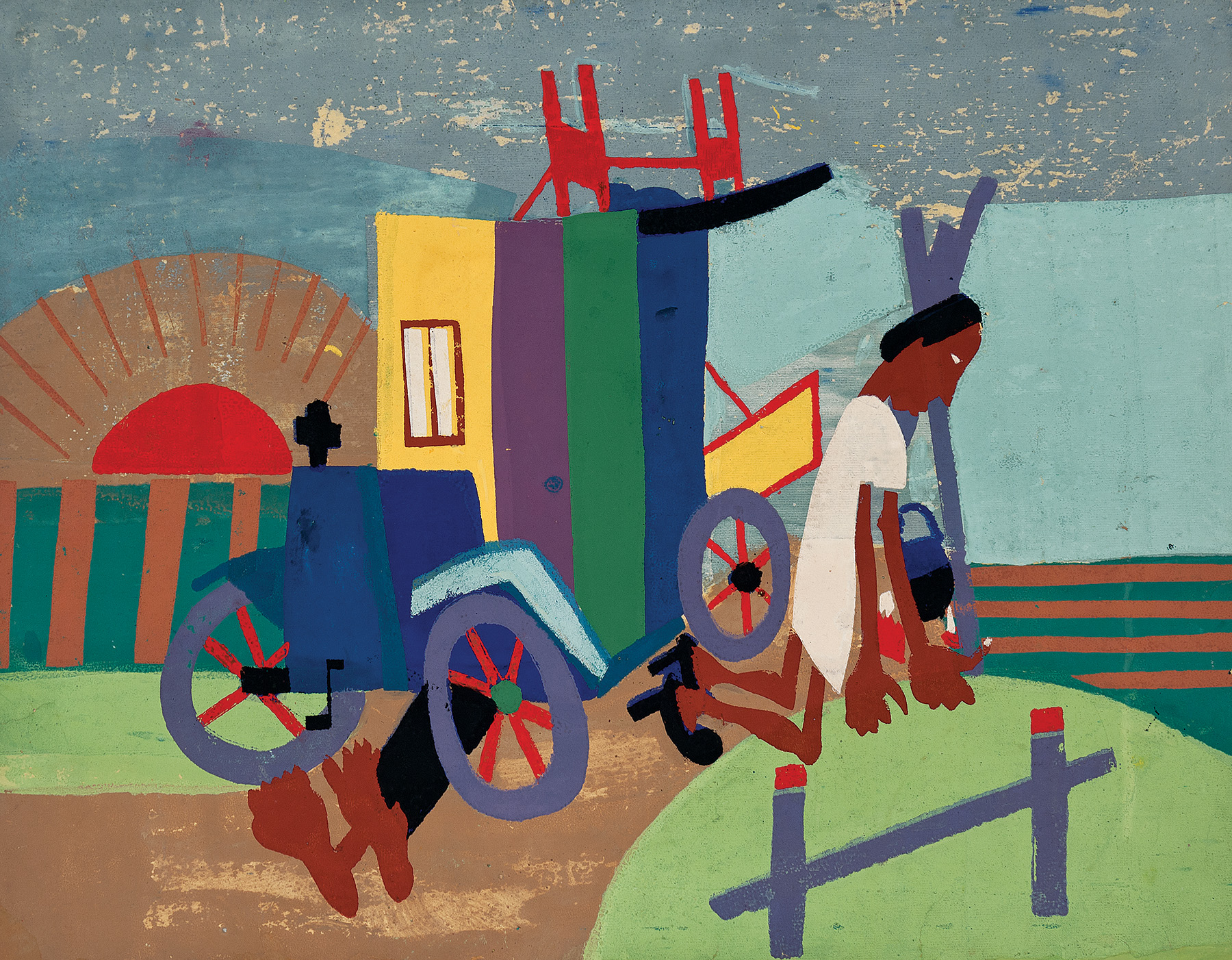William H. Johnson
William H. Johnson was one of the most prolific black artists of the Harlem Renaissance, whose spare, brightly colored modernistic scenes capture the spirit of the period. Born in Florence, South Carolina, Johnson showed an early aptitude for art, aspiring to become a newspaper cartoonist. In 1918, Johnson left his rural upbringing to pursue a new life in New York, joining an uncle in Harlem. The exodus of black families from the segregated South to the industrial cities of the North was known as the Great Migration, and it would have reverberating effects in American art and culture for generations.
In Harlem, Johnson worked numerous jobs in the service industry to earn enough money to attend the School of the National Academy of Design. Johnson studied with the artist and instructor Charles W. Hawthorne, renowned for his establishment of the Cape Cod School of Art in Provincetown, Massachusetts. Hawthorne was an influential teacher, encouraging Johnson to explore color in his early figurative paintings. Johnson earned numerous prizes and accolades for his work; however, he did not secure a desired scholarship to travel abroad. Hawthorne championed for the young artist and financed his trip to Europe in 1926, where he worked in Paris, Moret-sur-Loing, and Cagnes-sur-Mer. Johnson studied European modernism and painted expressionistic landscapes of France using vibrant colors and thick brushstrokes. In 1930, Johnson married the Danish artist Holcha Krake. The two spent most of the decade in Scandinavia, where Johnson developed a great interest in folk art and primitivism. He carried this deliberate naïve, or primitive style into his own art for the remainder of his career.
In 1938, Johnson left Europe at the outbreak of World War II and settled in Greenwich Village. He found employment as an instructor at the Harlem Community Art Center (HCAC), originally established by the sculptor Augusta Savage but run by the Works Progress Administration during the Depression. The Center was a vital resource for the Harlem community, fostering the careers of Johnson, as well as artists Charles Alston, Henry Bannarn, Selma Burke, Gwendolyn Knight, Jacob Lawrence and many others.
In New York, Johnson explored new subjects and mediums, including screen printing, a technique typically used for commercial art but repurposed by fine artists at the Center. Johnson was accustomed to wood block prints during his Expressionist period but embraced the new technique for its exuberance in color. Screen printing allowed Johnson to explore simplified forms, flat planes of bright color, and inexpensive opaque inks. Johnson simultaneously created paintings and screen prints during this period, using subjects related to the black experience. Johnson depicted everyday scenes from Harlem—street musicians and dancers, agrarian southern life, black American heroes, black soldiers, and religious imagery.
Johnson created a series of screen prints and paintings known as Breakdown in the early 1940s, depicting roadside car repairs and families camping out. The present screen print features a black couple stranded by the side of a rural country road, with their broke-down automobile piled high with furniture. The scene represents a familiar struggle experienced by many Americans during the economic Depression. However, the couple is undeterred by the breakdown, as the man repairs the car, and the woman creates a makeshift fire to prepare food. A cross-shaped hood ornament and the rising sun suggest their faith and optimism despite their hardship.
Johnson experienced commercial and critical success during the 1940s, however his physical and mental health declined following the death of his wife in 1944. Johnson left for Denmark in 1946 to be with his wife’s family. However, Johnson’s immense grief and his own untreated medical issues caused a mental breakdown and subsequent institutionalization. In a hospital in Oslo, he was diagnosed with syphilis, which impaired both mental and motor function. Johnson was forced to return to New York, where he entered the Central Islip State Hospital on Long Island. His belongings, including his artwork, were placed in storage. Johnson spent the last twenty-three years of his life at the hospital.
In 1956, Johnson’s artwork was almost destroyed when his caretaker declared him unable to pay further storage fees. Helen Harriton, Mary Beattie Brady, and others arranged with the court to have Johnson’s belongings delivered to the Harmon Foundation with unconditional rights over all works. The foundation would use the works to advance interracial understanding and support African American achievements in the fine arts. In 1967, the Harmon Foundation gave more than 1,000 paintings, watercolors, and prints by Johnson to the Smithsonian American Art Museum. SAAM now has the largest collection of the artists paintings and screen prints and has organized many exhibitions including the 1991 blockbuster retrospective, Homecoming: The Art and Life of William H. Johnson.
William H. Johnson
Breakdown, c. 1940-41
Pochoir with hand additions on paper
14″ x 18″ paper size
Inscribed on the upper center verso-Breakdown /FO-(1)593 / William H. Johnson
Provenance
William H. Johnson, New York, NY
The Harmon Foundation, New York, NY
Collection of Mary Beattie Brady, New York, NY
Estate of Mary Beattie Brady, Pawling, NY
Ed Roesch, Williamsburg, VA
Micheael Rosenfeld Gallery, New York, NY
Private Collection, Michigan, acquired from the above in 2o2o

